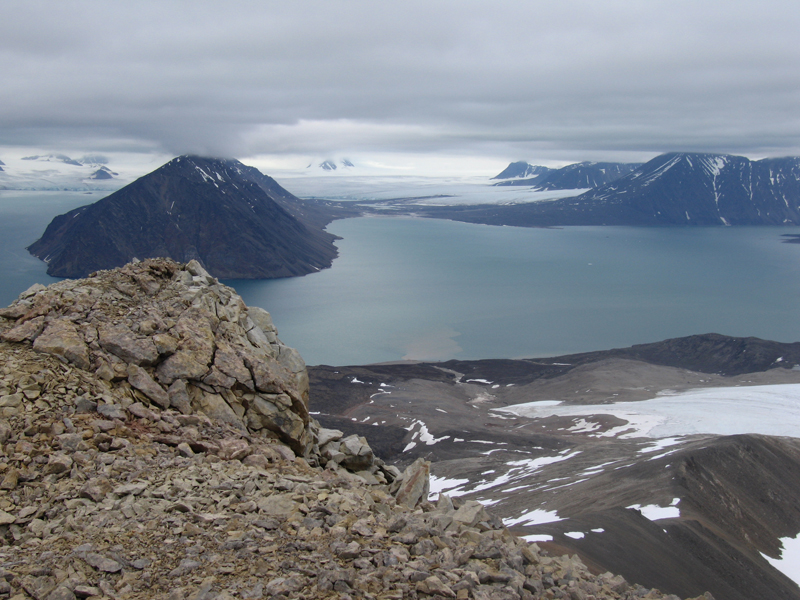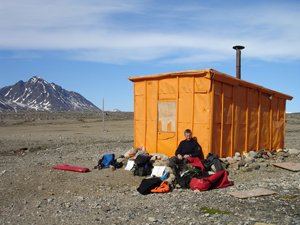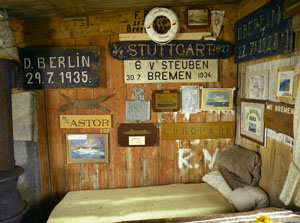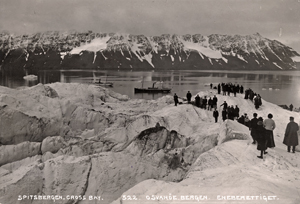Möllerhamna (Regnardneset)
[79° 16.8' N 11° 52' E]
By Øystein Overrein (ed.), Jørn Henriksen, Bjørn Fossli Johansen, Kristin Prestvold
The harbour of Möllerhamna is situated innermost in Krossfjorden. The area is known for its magnificent scenery that includes glaciers and nunataks. The majestic landscape is the reason why cruise ships have visited the place for nearly 100 years. At the headland of Regnardneset lies the “hotel” of Lloyds hotell, a cabin painted in bright orange, with affiliations to cruise tourism and to the company Hapag Lloyd.
 Lloyds hotell today. (Image: Lise Øvrum / The Governor of Svalbard) Take care:
- Lloyds hotell is a protected cultural remain, not to be disfigured or damaged.
- Don’t take or remove objects from the cabin. They are part of the cultural heritage.
- Don’t hang new signs.
- Don’t add graffiti to the walls in the cabin.
 View from the headland of Regnardneset toward the fjord of Möllerfjorden and the snow- and ice-covered mountain of Snødomen. (Image: Lise Øvrum / The Governor of Svalbard) View from the headland of Regnardneset toward the fjord of Möllerfjorden and the snow- and ice-covered mountain of Snødomen. (Image: Lise Øvrum / The Governor of Svalbard)
 Tourists visiting Lloyds hotell in the 1930s. Notice all the folding chairs. (Image: The Norwegian Polar Institute Photo Library) Tourists visiting Lloyds hotell in the 1930s. Notice all the folding chairs. (Image: The Norwegian Polar Institute Photo Library)
 The cabin interior bears witness to creative visitors over decades. (Image: Guri Dahl) The cabin interior bears witness to creative visitors over decades. (Image: Guri Dahl)
 Tourists walking on the glacier of Mayerbreen in the fjord of Möllerfjorden in the 1930s. (Image: O. Svanøe/The Norwegian Polar Institute Photo Library) Tourists walking on the glacier of Mayerbreen in the fjord of Möllerfjorden in the 1930s. (Image: O. Svanøe/The Norwegian Polar Institute Photo Library)
Möllerhamna is the name for the innermost part of the fjord of Möllerfjorden. The headland of Regnardneset separates Möllerhamna from the fjord of Kollerfjorden. At the eastern side of the fjord there are steep mountain peaks and two glaciers that calve into the sea – Mayerbreen and Kollerbreen. At the west side of the fjord lies the peninsula of Kong Haakons Halvøy.
At the strandflat in front of the mountain of Kronprins Olavs Fjell and innermost in Möllerhamna there is a large moraine. This is the remains of the glacier of Supanbreen, which previously terminated in a characteristic front in the fjord. The glacier has shrunken dramatically and retreated far back.
Lloyds hotell in Möllerhamna
Innermost in the beautiful fjord of Möllerfjorden, which is the eastern of the two arms of Krossfjorden, lies a small bright orange cabin popularly called Lloyds hotell, though hardly resembling anything like a hotel. The stunning natural environment boasts high peaks and glaciers that calve into the fjord. The orange spot at the tip of the headland is prominent even at some distance. The cabin is a landmark, meant to be seen.
Ever since the very start of the cruise ship traffic in Svalbard at the start of the 20th century, the fjord of Möllerfjorden has been frequently visited by tourists. Tourists were fascinated by the wilderness and the dramatic views of the area. Since then, the glacier fronts have retreated dramatically, but still the fjord displays mighty alpine landscapes of glaciers, fjords and mountains. Tourist ships have continually visited the fjord, except for a break of just a few years during World War II.
The small cabin of Lloyds hotell originally had a black roofing paper front, which is the traditional building style in Svalbard. A picture taken by Adolf Hoel in 1928 shows the original cabin at the site. Hence, the cabin was erected before 1928 and later painted orange. It is possible that the cabin was built already in the years between 1912 and 1914. In 1912 a large joint German expedition visited the fjord and undertook several occupations. The shipping company Hamburg Amerikalinje, or Norddeutscher Lloyd, was one of the interested parties, and the company occupied the area where Lloyds hotell is located today.
The cabin interior tells the story of a long tradition of cruise ship traffic in the area and landings at the site of the cabin for more than 100 years, which makes the cabin one of the few cultural remains in Svalbard with a pronounced and close affiliation to the history of tourism in the archipelago. Inside the cabin, the walls are decorated with graffiti and signs from ships that have visited the place throughout the years. Several of the signs on the walls are from the interwar years, from a time when Europe was changing dramatically and was on the brink of war. Still, people found time to go for cruise ship holidays up north. Or was this actually the reason to go? The cabin is an interesting reminiscence of this particular European epoch.
Today, particularly ships from the Hapag Lloyd company land at the Lloyds hotell every year, and all landings are written down in a guest book at the table in the cabin. The rest of the cabin interior is also marked by all the tourist visits over the years, for example, in the form of a representative selection of bottles and a well-supplied medicine cupboard.
The cabin is a protected cultural remain with a history from the time of cruise ship tourism in the archipelago. In 2003, the Governor of Svalbard decided to clean the cabin and the surrounding area, as the area was highly marked by all the landings over the years. Numerous cairns were removed, several bonfire sites were cleared and waste and rubbish collected. Pallets and other rubbish piled by and inside the cabin were burned. Food and other refuse from several years were removed. Today the cabin and the area around it appear tidy. The cabin lies in an area of wilderness where signs of human presence should be made minimally visibly in the natural environment. Bonfire sites and cairns are not consistent with these goals. Leaving waste is prohibited. A cultural heritage site is not to be used as storage. It is also forbidden to make bonfires within a 100 m zone around the cultural remains.
Vulnerable elementsThe cabin and interior. Do not remove loose or wall-mounted objects. Landing sitesThe best place for landings is the east side of the headland of Regnardneset.
|